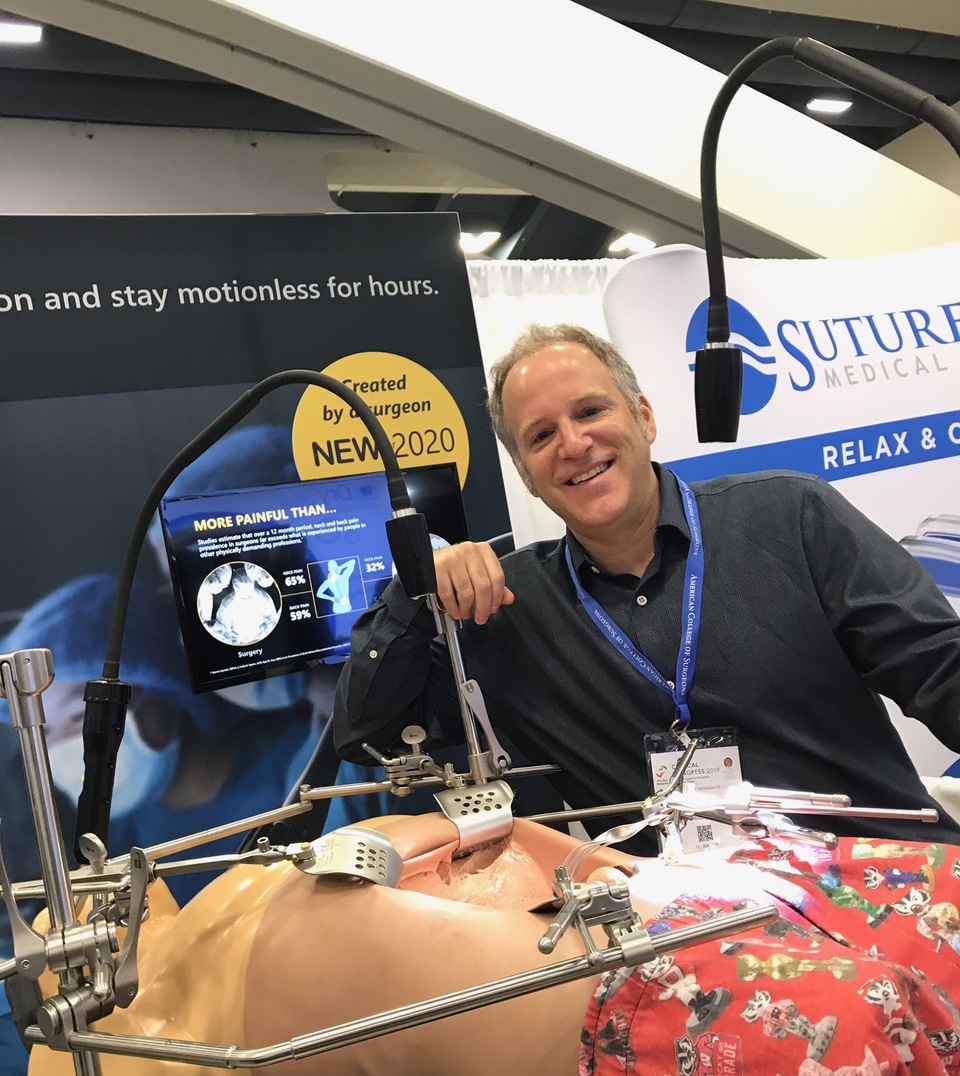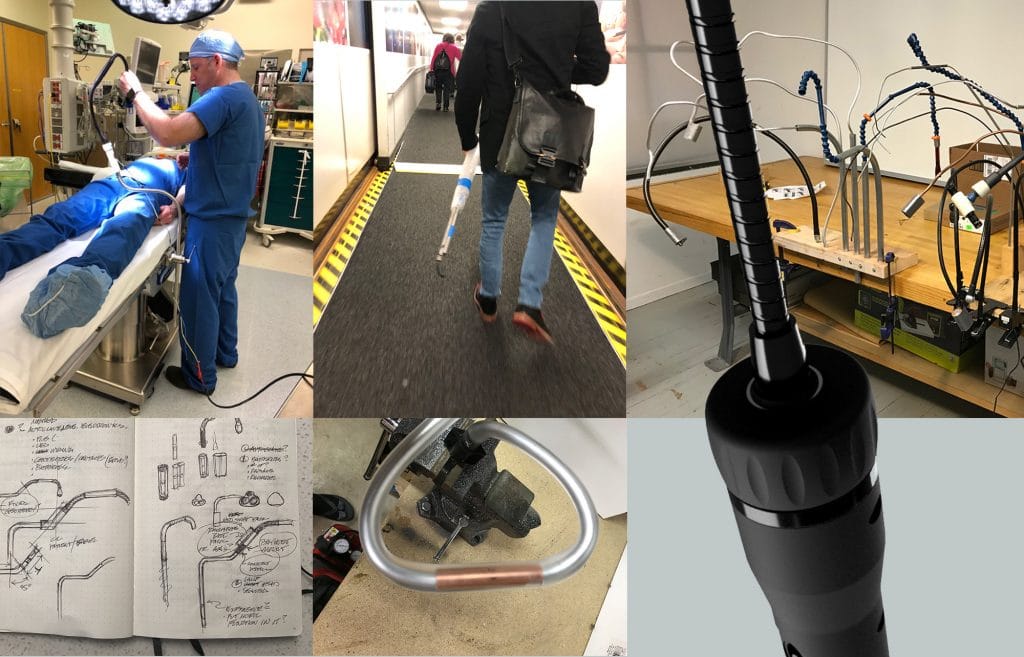Shining Light on Great Med Tech Product Design: A Q&A With MezLight

Share:
We love working on product design with our clients, especially in the area of medical technology. We’re right at home when we get a chance to roll up our sleeves and find a solution alongside the people who use our flex arms. That’s why MezLight has been such a great experience.
MezLight is a small company with a big idea. Envisioned by Dr. Josh Mezrich, a transplant surgeon at UW-Madison, MezLight offers an alternative to bulky headlamps that many surgeons are forced to wear during surgery. MezLight’s solution? A robust but supple flex arm that’s attached to the table and can give bright illumination wherever it’s needed. That meant finding a flex arm that was strong enough to stay put — but could still be easily adjusted with one hand. Since it would be utilized during surgery, it had to be able to be cleaned and sterilized with an autoclave to allow for reuse.
We sat down with Bill Dorr, Director of Product Design, and Heidi Dorr, Director of Marketing at MezLight to learn a bit about their design process and what it’s like to be a small startup with a potentially industry-shaking idea.
On your website, it says you had more than 20 prototypes before MezLight1.0 How did MezLight go from the idea to the prototyping process?
Basically, a headlamp gives focused, really bright illumination on the anatomy of the surgical area during open surgeries. The problem is that these headlamps are just too heavy. Dr. Mezrich would say, “My neck’s killing me, my wife’s (also a surgeon) neck is killing her.” It got so bad that he would ask the residents to wear the headlamp so that he could perform surgery unencumbered. The headlight is just not that great — it’s terribly uncomfortable for surgeons. You don’t want that during surgery.

Dr. Mezrich prototyped the medical device himself?
Dr. Mezrich got together with his next-door neighbors, the Christianson’s, they self-funded, then worked with an engineering firm, and produced a fully functional prototype — they had an idea about what they wanted and where to go next. We joined the crew. I (Bill) got involved because of my Industrial Design background and because this was a product idea that would be highly beneficial to surgeons.
What were some of the early challenges you faced in product design?
When we started testing the original prototype, we knew we’d need to make some changes. One of the biggest was the flex arm. The one we had at the time wasn’t going to be durable enough — it just couldn’t last very long. Originally the business model was for a sterile one-time-use, disposable product. After getting feedback from surgeons and healthcare professionals, it was clear that it had to be reusable. We knew we had to try something else.
How did you decide on a sturdier flex arm?
We needed a flex arm that could do a number of things that are dichotomous. It had to be really flexible to be manipulated easily, but when you let go you needed it to stay in place. There are lots of physics and mechanics involved and finding the right balance isn’t easy. It also needed to be able to be sterilized in an autoclave. That was a must for us as we moved away from a one-time use product.
For our audience, what is an autoclave?
An autoclave uses hot steam and pressure to sterilize surgical instruments. So the entire light needed to be able to withstand a harsh environment, not just once but many times. A gooseneck/flex arm appeared to be the best way to address the problem, but now we needed to find someone who could make goosenecks. I said, “I doubt there’s anyone who makes these in the US.”
I have experience with suppliers overseas and China makes most everything. I never thought there would be a chance of finding a US supplier. I managed to find one that was so-so to work with. They gave us some samples but weren’t very proactive in helping us address the mechanics issues. We needed to find someone who could work with us.
That’s where Moffatt came in? What was that initial interaction like? How did it affect product design?
My wife, Heidi, MezLight’s Director of Marketing, found Moffatt. We got in contact with them and from the first conversation we were confident that they could provide a solution. So we got to talking with them, showed them what we wanted to do. One of the great things about Moffatt is that they’ve been really willing to help us engineer the final design at no cost. This has been critical to helping us achieve the design we need. They also engaged with us like we’re a big company, not a garage startup. Moffatt worked with us patiently to design and create numerous prototype arms using different materials before we landed on the right solution.
Another big plus is that Moffatt is already familiar with the medical device market and understood that the heat shrink material covering the flex arm needed to be latex free.
How is working with Moffatt during product design different from working with other parts manufacturers?
Working with the engineering and sales teams at Moffatt has been a great experience. Moffatt is a smaller, family-owned company so they have been willing to go the extra mile and basically bet on us with no guarantees. They truly care about the quality and performance of the end product. It’s been a really great experience.
Moffatt has a background in product design and engineering. The process is important to them. Was that important to have a collaborator as problems came up?
Very much so. It is important when you’re working with a supplier that they proactively help you solve issues as they arise and bring their expertise to the table. We’ve been in a lot of different situations with a lot of different vendors and you have to have one that collaborates with you – especially without whining *laughs* – and wants to make you successful — that’s huge. Frankly, we wouldn’t have been able to get to where we’re at now without them — we’d still be messing with the gooseneck *laughs*
What are the challenges for a small company vs a big company when it comes to product design?
A big company has more resources for product design, but there’s also more bureaucracy. You need a budget approved. The design process can be a lot more laborious. We like the freedom that we’ve enjoyed in designing this product and we are grateful for our private investors who have provided the financial support necessary to make MezLight a reality.
What comes next for you in the design process?
We are in the final phase of development and beginning our transfer to manufacturing. Currently, we plan to be in production before July of this year…and if all goes according to plan we will be using a lot of Moffatt goosenecks in the near future.
Want to learn more about how Moffatt can help? Let’s chat!
We’re here to provide you the expertise and flex arm options that you’ll need to make sure that your device becomes the best possible version of itself. That doesn’t stop after production. We’re here for the lifetime of your device.
